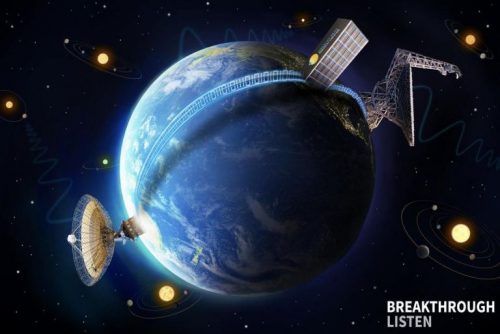The materials will be open to citizen scientists (ordinary people who contribute to science) who will try to find in them signs of transmissions originating from technological intelligence outside the solar system

Last week (Friday, February 14), the nonprofit organization Breakthrough Listen released for listening about 2 petabytes of optical and radio data they have accumulated over the past four years. This is the second publication of the Breakthrough Initiative and the public is once again invited to search the data for possible signs of communication created by intelligent beings outside of Earth.
The announcement was made at a media briefing in Seattle, where the annual meeting of the American Association for the Advancement of Science (AAAS) was held. During the event, Andrew Simion – director of the UC Berkeley SETI Research Center and principal investigator of Breakthrough Listen – presented the latest data obtained by the project.
"Since publishing the first Breakthrough Listen data last year, we have doubled the amount of data available to the public. It is our hope that these data sets will reveal something new and interesting, whether it is other intelligent life in the universe or whether it is a natural astronomical phenomenon that has yet to be discovered." says Simion.
The Breakthrough Listen project, based at UC Berkeley, is collecting mountains of data from observations by the Green Bank Telescope in West Virginia and the Parkes Radio Telescope in Australia (left). Credit: Breakthrough Listen
As of today, Breakthrough Listen is the most extensive and ambitious SETI program ever conducted, which aims to find evidence of intelligent life through the study of cosmic radio waves. Once complete, it will examine about a million of the nearest stars in our Galactic Neighborhood and the center of our galaxy, as well as the 100 closest galaxies.
The survey relies on the Parkes Radio Telescope in New South Wales, Australia, and the Bank Green Optical Telescope in West Virginia, as well as the Automatic Planetary Observatory (APF) stationed at the observatory near San Jose, California. The location of these telescopes makes them ideal for scanning the entire disk of the Milky Way galaxy and the region surrounding the supermassive black hole (SMBH) at the center of our galaxy – known as Sagittarius A*.
In this case, the survey data included the signals at frequencies of 1 to 12 GHz in the radio spectrum from the plane of the Milky Way, the central region of our galaxy, and the interstellar comet 2I / Borisov.
Simeon particularly highlighted a smaller data set that looked at the twenty closest stars aligned with Earth's orbit. For advanced civilizations living in one of these star systems, Earth can be detected as it passes in front of our Sun relative to them.
This method of discovering planets, known as Transit Photometry, is the most effective way to confirm the existence of planets around other stars and was the method used by the Kepler space telescope - and is currently used by the TESS satellite. This is why this subgroup was named, "Survey of the Trans-Earth Region."
This survey was conducted using the Greenbank Telescope. As part of it, these 20 stars were scanned in a frequency range of 4 to 8 GHz. The telescope observed each star for five minutes, cycled through five more stars, and then repeated the same process two more times. However, after processing that included the deletion of signals originating from Earth-generated disturbances, four signals remained, so they were all attributed to orbiting satellites.
In addition to this second data release, the National Radio Astronomy Observatory (NRAO) and the SETI Institute recently announced that they are entering into a new partnership. Pursuant to this agreement, the two organizations will collaborate to add SETI capabilities to radio telescopes operated by NRAO.
The first project will participate in the National Science Foundation's famous Jansky Foundation Very Large Array (VLA) in New Mexico, where the SETI Institute will install a state-of-the-art digital backup interface that allows astronomers unprecedented access to the rich stream of data the array provides. This upgrade is expected to enable SETI surveys that are far more comprehensive and detailed than any previously conducted by the VLA.
Adapted from an article published on the Universe Today website
More of the topic in Hayadan:
- Documents were revealed, UFOs were not found
- In the last twenty years we have discovered a lot of planets, so why haven't we found aliens?
- Yuri Milner's Breakthrough Starshot project will fund a search for planets in the Alpha Centauri system
- How many Earth-like planets orbit Sun-like stars in the habitable zone?

2 תגובות
Available on Spotify?
Why invest a lot of energy and money in the search for extraterrestrial life?
There is still an incredible variety of creatures on Earth today that we systematically abuse every day
A day in the dairy industry, eggs and meat and more. We systematically exterminate the rest (poisoning, pollution, reduction of living space).
What will we do if we find extraterrestrial life?
These are the options after a brief cordial introduction:
1. Less intelligent beings - we will take advantage of them and abuse them to our advantage.
2. Creatures roughly like us - over time we will fight them for control of territories, resources and ego.
3. Creatures smarter than us - ...they will exploit and abuse us (apparently this is how nature works).
More details about humanity's abuse of animals (don't do anything, just don't say we didn't know):
https://eisaak123.wixsite.com/animals
A little about me:
https://eisaak123.wixsite.com/privatelessons